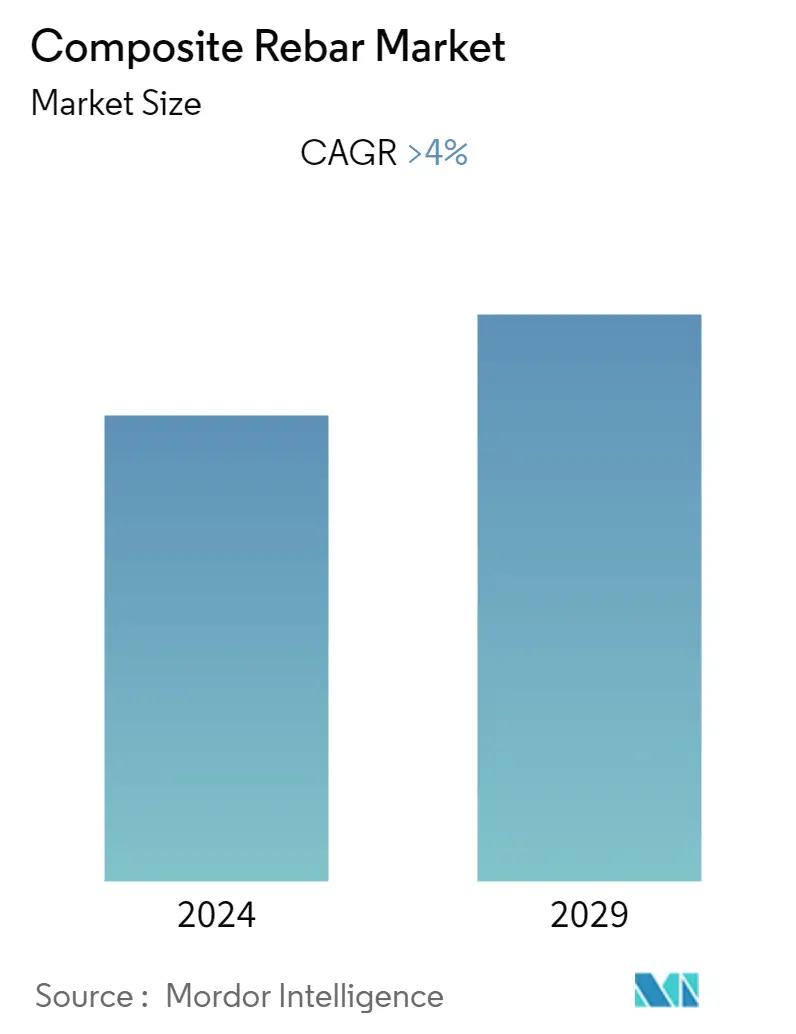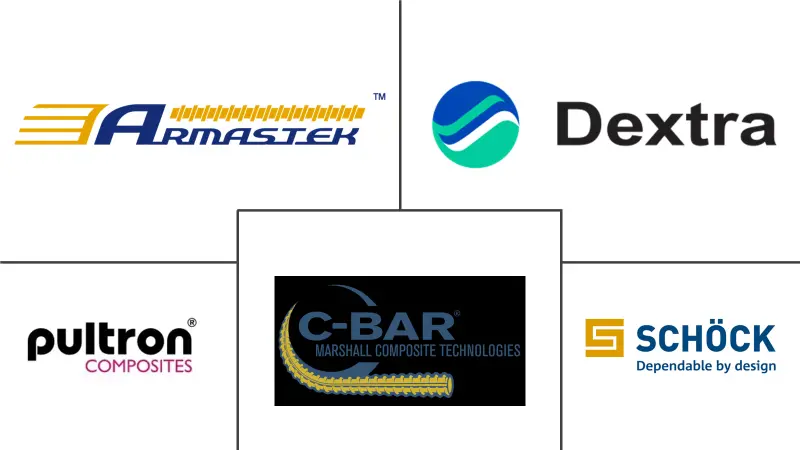Market Size of Composite Rebar Industry

| Study Period | 2019 - 2029 |
| Base Year For Estimation | 2023 |
| CAGR | 4.00 % |
| Fastest Growing Market | Asia-Pacific |
| Largest Market | North America |
| Market Concentration | Low |
Major Players
*Disclaimer: Major Players sorted in no particular order |
Composite Rebar Market Analysis
The global composite rebar market is projected to register a CAGR of more than 9% during the forecast period (2022-2027).
Composite rebars made from either carbon-fiber-reinforced or aramid fiber-reinforced polymer or glass fiber-reinforced polymer can be readily formed into complex shapes through the pultrusion manufacturing process. Composite rebars have been used by the civil engineering construction industry in the past few years. However, following the outbreak of the novel Coronavirus, nationwide lockdowns around the world, disruption in manufacturing and supply chain activities, production halts, and labor unavailability have negatively impacted the market. However, in 2021, the situation began to get back on track, and now the market is stable and growing steadily.
Over the short term, the increased usage of composite rebars in highways, bridges, and building construction activities is a driving factor stimulating the market demand.
Construction professionals and experts do not prefer using fiber-reinforced polymer rebar in concrete structure reinforcement applications due to the lack of American Society for Testing and Materials (ASTM) guidelines. This is likely to hinder the market in the forecast period.
The construction industry is growing at a fast rate in APAC countries such as India, China, and Japan due to the rising population, rapid urbanization, and huge industrial and revenue growth.
Composite Rebar Industry Segmentation
The composite rebar market is segmented by product type, application, and geography. By product type, the market is segmented into glass fiber reinforced polymer rebar (GFRP rebar), carbon fiber reinforced polymer rebar (CFRP rebar), and basalt fiber reinforced polymer rebar (BFRP rebar). By application, the market is segmented into highways, bridges & buildings, marine structures & waterfronts, water treatment plants, and other applications. The report also covers the market sizes and forecasts for the composite rebar market in 16 countries across major regions. For each segment, the market sizing and forecasts have been done on the basis of value (USD million).
| Product Type | |
| Glass Fiber Reinforced Polymer Rebar (GFRP Rebar) | |
| Carbon Fiber Reinforced Polymer Rebar (CFRP Rebar) | |
| Basalt Fiber Reinforced Polymer Rebar (BFRP Rebar) |
| Application | |
| Highways, Bridges & Buildings | |
| Marine Structures & Waterfronts | |
| Water Treatment Plants | |
| Other Applications |
| Geography | ||||||||
| ||||||||
| ||||||||
| ||||||||
| ||||||||
|
Composite Rebar Market Size Summary
The composite rebar market is experiencing steady growth, driven by its increasing application in civil engineering projects such as highways, bridges, and buildings. These rebars, made from materials like carbon-fiber-reinforced, aramid fiber-reinforced, or glass fiber-reinforced polymers, offer significant advantages over traditional steel rebar, including higher tensile strength, corrosion resistance, and lightweight properties. Despite challenges posed by the COVID-19 pandemic, which disrupted manufacturing and supply chains, the market has stabilized and is expanding, particularly in regions experiencing rapid urbanization and infrastructural development, such as Asia-Pacific. However, the lack of standardized guidelines from the American Society for Testing and Materials (ASTM) remains a barrier to wider adoption in concrete structure reinforcement applications.
North America is poised to dominate the composite rebar market, with the United States leading due to its substantial construction industry and recent infrastructure investments. The region's aging infrastructure presents a significant opportunity for composite rebars, which are ideal for rehabilitating deteriorating concrete structures. The market is characterized by fragmentation, with key players like Armastek, Schock Bauteile GmbH, Dextra Group, Pultron Composites, and Marshall Composite Technologies LLC actively expanding their global presence through strategic partnerships and joint ventures. These developments are expected to further drive demand for composite rebars, as governments and private firms seek sustainable and durable construction materials to enhance asset longevity and reduce maintenance costs.
Composite Rebar Market Size - Table of Contents
-
1. MARKET DYNAMICS
-
1.1 Drivers
-
1.1.1 Increasing Usage in Highways, Bridges, and Buildings
-
1.1.2 Increasing Demand in Marine Structures
-
-
1.2 Restraints
-
1.2.1 Low Acceptance of FRP Rebars Among Construction Professionals
-
1.2.2 Other Restraints
-
-
1.3 Industry Value-Chain Analysis
-
1.4 Porter's Five Forces Analysis
-
1.4.1 Bargaining Power of Suppliers
-
1.4.2 Bargaining Power of Buyers
-
1.4.3 Threat of New Entrants
-
1.4.4 Threat of Substitute Products and Services
-
1.4.5 Degree of Competition
-
-
-
2. MARKET SEGMENTATION
-
2.1 Product Type
-
2.1.1 Glass Fiber Reinforced Polymer Rebar (GFRP Rebar)
-
2.1.2 Carbon Fiber Reinforced Polymer Rebar (CFRP Rebar)
-
2.1.3 Basalt Fiber Reinforced Polymer Rebar (BFRP Rebar)
-
-
2.2 Application
-
2.2.1 Highways, Bridges & Buildings
-
2.2.2 Marine Structures & Waterfronts
-
2.2.3 Water Treatment Plants
-
2.2.4 Other Applications
-
-
2.3 Geography
-
2.3.1 Asia-Pacific
-
2.3.1.1 China
-
2.3.1.2 India
-
2.3.1.3 Japan
-
2.3.1.4 South Korea
-
2.3.1.5 Australia
-
2.3.1.6 Rest of Asia-Pacific
-
-
2.3.2 North America
-
2.3.2.1 United States
-
2.3.2.2 Canada
-
2.3.2.3 Mexico
-
-
2.3.3 Europe
-
2.3.3.1 Germany
-
2.3.3.2 United Kingdom
-
2.3.3.3 Italy
-
2.3.3.4 France
-
2.3.3.5 Rest of Europe
-
-
2.3.4 South America
-
2.3.4.1 Brazil
-
2.3.4.2 Argentina
-
2.3.4.3 Rest of South America
-
-
2.3.5 Middle-East and Africa
-
2.3.5.1 Saudi Arabia
-
2.3.5.2 South Africa
-
2.3.5.3 Rest of Middle-East and Africa
-
-
-
Composite Rebar Market Size FAQs
What is the current Composite Rebar Market size?
The Composite Rebar Market is projected to register a CAGR of greater than 4% during the forecast period (2024-2029)
Who are the key players in Composite Rebar Market?
Armastek, Schock Bauteile GmbH, Dextra Group, Pultron Composites and Marshall Composite Technologies LLC are the major companies operating in the Composite Rebar Market.

